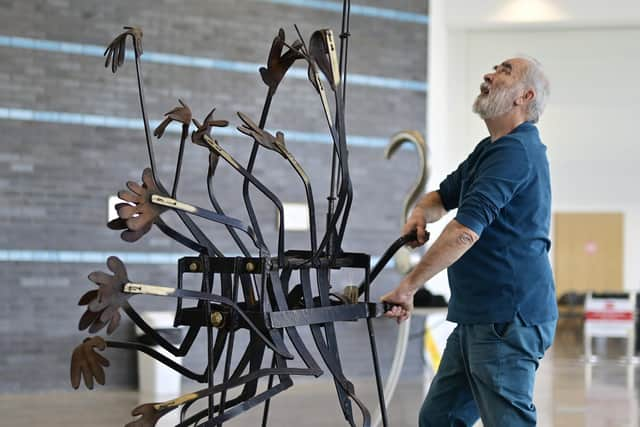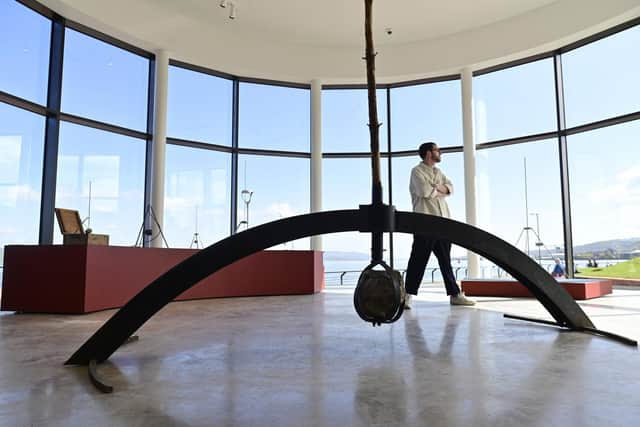Art review: I Once Went Down to the Sea Again, The Wyllieum, Greenock
I Once Went Down to the Sea Again, The Wyllieum, Greenock ****
The Wyllieum has opened in Greenock. Dedicated to the art of George Wyllie, it is Scotland’s first new-build art space for quite some time. It is not a museum, however. Wyllie was too vital, too mercurial to be pinned down in glass cases, so the name Wyllieum has been devised to suggest something of his uniqueness. It is now the principal depository of his work and the plan is to make changing exhibitions from this resource as well as staging a permanent display about his life and work.
Advertisement
Hide AdThe building designed by Richard Murphy is beautiful and is set in a beautiful position, right on the Firth of Clyde. The Dunard Fund was a major donor for the Wyllieum itself, but it is part of a new Ocean Terminal owned by Inverclyde Council and evidently built with government funds provided by various routes. As well as the Wyllieum, signage outside announces the Greenock Ocean Terminal and Scott’s Restaurant which occupies the upper floor of the building. Rent is part of the income stream. Cruise ships will be another. Around 120 are booked for the coming year.


As you approach, set between what could be the bases of two round towers, the entrance is welcoming. Step inside and full-height windows set in a wide concave embrace a magnificent panorama of the Firth of Clyde and the Argyll hills beyond. Beyond the windows is a broad terrace open to the sea. There are no seats on the terrace, just the stone benches of a tiny amphitheatre set into the pavement, a nice performance space, weather permitting, but whether the architect wanted them or not, there will be seats. It’s too tempting.
One piece of Wyllie’s sculpture is displayed here, his splendidly crazy A Machine for Applauding Paintings with Critic’s Thumb Attachment, a roller with handle and clapping hands attached and critic’s thumb above. As he once did when he served as a customs officer in Greenock, Wyllie will preside over the comings and goings of the port.
On the left of the atrium is a big meeting space for cruise passengers. On the right is a shop and then the Wyllieum itself. The main exhibition space is at the eastern end of the building and is approached through a smaller gallery, a lobby really, with a second small space adjacent. This area is packed with a summary of George’s life and achievements. Born in 1921, he initially trained as an engineer, but later like Robert Burns, the Douanier Rousseau and indeed Geoffrey Chaucer, he became a customs officer. He began to make art while still working in customs and held his first exhibition in 1965. His work at that time was mostly comical sculptures made from welded steel. It was only after he had retired that his creative talents really began to flourish. I remember a conversation I had with him in the late 1970s. He was debating with himself whether he should work in a simply comic vein or should become more serious. It was a rather Scottish debate he was having with himself. David Wilkie and Burns were both assailed by similar doubts. In the event all three, Burns, Wilkie and Wyllie himself, resolved the dilemma by managing to be both comic and serious at the same time, indeed being profoundly serious by being comic.
There is much else, but the most notable things in the introductory display that tells this story are models, photographs, drawings and films on small screens of his Straw Locomotive and Paper Boat. The first was a life-size model of a steam locomotive. Made of straw in 1987, it was hung from the Finnieston crane as its steel predecessors had been as they were slung into waiting ships. The Straw Locomotive was then processed through the streets and burnt like a Viking ship. It was a magnificent obsequy for Glasgow’s heavy industry.


The Paper Boat, made in 1989, was an equally potent metaphor. It too was a lament, in this case for the loss of the Clyde’s ship-building. Steel had proved as fragile and fugitive as paper, but the Paper Boat was not just a lament. Paper may be fragile but it is a potent vehicle for ideas and like boats, ideas can travel. The Paper Boat carried the text of Adam Smith’s Theory of Moral Sentiment to London and to New York, to counter the misapplication of Smith’s Wealth of Nations in these centres of capital with his idea that it is sympathy that makes society possible.
Advertisement
Hide AdBoth these great projects reflected Wyllie’s disgust at the actions of Margaret Thatcher’s government and their disastrous social consequences. They have real socio-political heft, but presented with the kind of bold innocence that made him unique and which was reflected in his willingness to question any prevailing consensus. At the heart of both the Paper Boat and the Straw Locomotive, revealed when in the latter was burnt, stood a question mark. On the wall here hangs Wyllie’s Shaman’s Staff, a bishop’s crozier with a question mark for a hook. Wyllie was the Wh?sman. Questions matter much more than answers. They open possibilities. Answers close them.
Given the drama of these works and also the drama of Wyllie’s performances, it is perhaps a shame that the first exhibition in the main space, I Once Went Down to the Sea Again, is devoted to his Spires. They were a vital expression of Wyllie’s ideas certainly, but in what for most people will be an introduction to the work of an unknown artist, they don’t have the presence of some of his more rhetorical works. Nor indeed the fun – he was a great performer on the ukulele – and that was vital. Indeed, if Oor Wulllie had grown up to be an artist, he might have been a bit like Wyllie. Of course, Oor Wulllie never would grow up. Nor in a way did Wyllie, but we don’t see that so easily in his Spires.
Advertisement
Hide AdMuch inspired by his friendships with Joseph Beuys and the American master of mobile sculpture, George Rickey, in these works Wylie engaged with environmental questions. They are composed of a tripod or other base which supports a tall, lance-like pole. As this points skyward, it is balanced by a heavy, earth-pointing rock hanging from its base. Set in gimbals like a ship’s compass, the Spires swing between the sky above to which they point and the earth beneath towards which they are weighted. Inspired by the ideas of the pioneer ecologist Patrick Geddes, they are an elegant visual metaphor for what Geddes called synergy, the need for balance. It was a theme in much of Wyllie’s later work and one which he also illustrated with magnificently zany bicycles. Bicycles too are models of balance, and of intuitive balance within us. As Wyllie pointed out, learning to ride a bicycle is a unique moment and thereafter you can’t unlearn. A couple of his bicycles could have enlivened this display. But that is a mere cavil. The Wyllieum is a magnificent achievement and through it the lessons Wyllie taught us will live on. We should be ever grateful for those dedicated souls who have brought it about.
Until 24 August
Comments
Want to join the conversation? Please or to comment on this article.